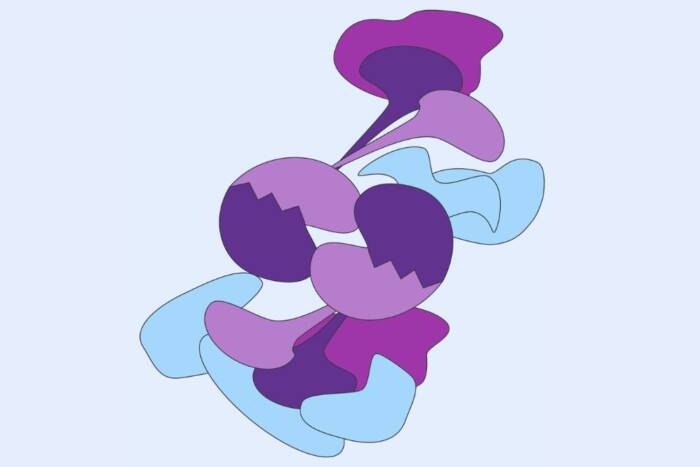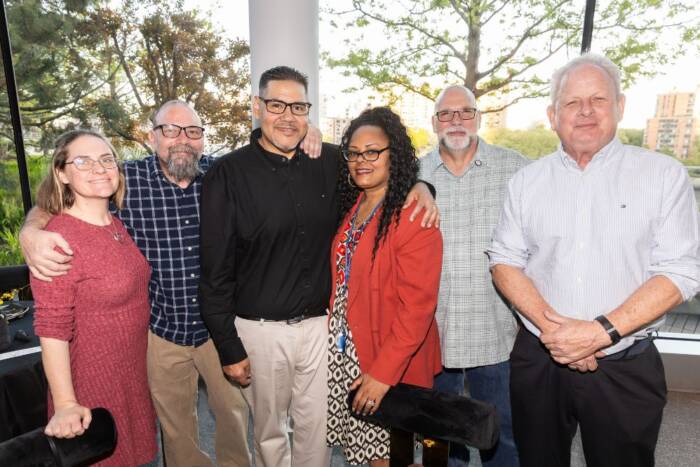Silence of the genes
New theory explains how gene-silencing “glue” can be removed
In addition to nails and screws, a carpenter’s bag of tricks includes glue. Nails can be pulled, screws can be removed, but glue is typically permanent.
Nature uses its own version of glue to jam a gene’s expression when its activity could somehow disrupt the body’s functioning. For example, nature’s “glue” silences one of the two copies of the X chromosome that female mammals carry in their body cells during early development to ensure that the embryo doesn’t get double doses of the same genes. Recent scientific evidence suggests that “gluing” or compacting mechanisms in the cell’s nucleus might control the activity of large regions of the genome.
But how genes in such silenced regions could be reactivated has remained a mystery. New theories reported by a team of Rockefeller University scientists led by C. David Allis, Ph.D., in the October 2 issue of the journal Nature might explain how a cell deals with “glue” in the nucleus and provide new strategies for developing anti-cancer treatments.
“Nature’s glue is not the glue we know from carpentry — it’s not permanent,” says coauthor Wolfgang Fischle, Ph.D., a postdoctoral fellow in Allis’ laboratory. “In all cases in biology that we know, these interactions are dynamic. That gives the cell options for regulation. You don’t want to have something bind and be stuck there forever. Then there’s no regulation, and life is all about regulation, at least for the cell.”
In their conceptual study, Allis, Fischle and Yanming Yang, Ph.D., suggest that “binary molecular switches” operating through chemical reactions are the key to dynamic regulation of the cell’s “glue.” These reactions are centered on proteins called histones, the spool-like proteins around which DNA wraps itself in the cell’s nucleus.
Allis and colleagues go on to show that such “post-translational” histone modifications – chemical changes to the protein after it has been synthesized — often appear in high-density clusters. These clusters, termed “modification cassettes,” can also be found in non-histone proteins. The findings could offer general rules as to how proteins that engage appropriately modified histone proteins may be released at key times in the cell cycle or in development.
“As we begin to understand more and more about the role of genes in human health and disease, we find that the body has evolved mechanisms for passing on genetic information that go beyond what is occurring simply at the level of the DNA sequence,” says Rockefeller University President Paul Nurse, Ph.D. “Now, David Allis and his colleagues have developed an elegant theory that may explain how so-called ‘epigenetic silencing’ occurs in our cells and how it may be reversed.”
The chemical reactions that Allis, who is the Joy and Jack Fishman Professor at Rockefeller, focuses on are called “covalent” modifications: chemical marks or flags that affect the amino acids that make up the histones’ “tails,” long, flexible protein chains that poke through chromatin, the tightly folded structure that contains coiled DNA and histones.
A role for histones in gene activation first became known in the 1960s, when the late Vincent G. Allfrey, Ph.D., and colleagues at Rockefeller made seminal contributions to understanding how histones control gene activation in higher organisms. Allfrey’s experiments provided evidence that histones are modified by enzymes that attach acetyl, phosphoryl or methyl chemical groups to them.
Many scientists, including Allis, theorize that these chemical modifications are in part responsible for passing on inherited traits without changing the sequence of DNA, an area of research called epigenetics. It is now widely accepted that such non-DNA encoded heritable information has important implications for human biology and human disease, especially cancer. An internationally recognized leader in epigenetics, Allis joined Rockefeller in March 2003.
Allis and other researchers over the last decade have identified many of the enzymes that attach and remove these modification marks — methyl, phosphate or acetyl — to specific amino acids in the tail. The phosphate and acetyl modifications can be reversed by separate enzymes, which “strip” the mark off the amino acid.
The methyl mark on lysine residues, however, appears to be more permanent, and may be irreversible. While scientists know several enzymes that attach methyl chemical groups to different amino acids on the histones, no one has yet identified an enzymatic activity that can remove a methyl mark. Because of this lack of dynamic addition and removal, methyl marks are considered to be “static” and might be heritable.
“That’s an attractive possibility,” says Allis. “If methyl groups get put on, and then are never removed, they would be perfect epigenetic marks, especially if they were propagated or inherited from one cell to the next.”
Research in the last few years by Allis’ group at Rockefeller and at the University of Virginia, where he was a faculty member before moving to Rockefeller, has focused on methylation of the amino acid lysine and the role of methylation in silencing genes.
According to recent findings by Allis’ team, methylated lysines on the histone tails recruit proteins that the researchers call “effectors.” Effectors, if they are repressive in character, pull the histones together and therefore “glue” the chromatin shut. This effectively prevents the cell’s machinery from getting near DNA, where it would normally read and copy the genetic information stored there in a complex process called transcription. But the “effector glue” essentially shuts down any gene activity.
“If a repressive effector binds to a methylated lysine, how does the cell remove the effector when it needs to activate or reactive a gene?” asks Allis. “Our model proposes that phosphorylation, which is a readily reversible reaction, serves as the ‘ejector’ button or switch.”
Allis and his colleagues analyzed the sequence of amino acids that make up the histone tail, and noticed an interesting pattern: adjacent to essentially every known methylated lysine residue in histones was a serine or a threonine. Both of these amino acids can “accept” a phosphate in a process called phosphorylation. Could this be a coincidence?
Allis and Fischle contend it is not.
They propose that the lysine/threonine or lysine/serine pairs act like “binary molecular switches.” Because the methyl marks on lysine are considered permanent, they believe that phosphorylation of an adjacent or neighboring serine or a threonine somehow weakens the bond that the effector protein has with the methylated lysines.
Therefore, in this model, although the methyl mark can’t be removed, the chemical reaction occurring during phosphorylation can, in a sense, dissolve the glue that holds the chromatin together. Once the glue is removed, the chromatin relaxes and opens up, allowing the cell’s transcription machinery to gain access to the genes and activate them.
“Our preliminary testing of the feasibility of ‘switching mechanisms’ look very promising,” says Fischle. “If the new theories prove indeed to be correct, they could pave the way for novel strategies in the development of gene regulatory drugs – an important goal in anti-cancer treatment schemes.”
The Rockefeller researchers made another interesting observation regarding the amino acid sequence of the histone tails.
Amino acid modifications on histone tails appear very frequently: in stretches spanning five amino acids, as many as three marks are found. The researchers call such clusters of high-density marks “cassettes” or “modification hot spots.”
“Cassettes could represent separate regulatory units for the cell,” says Fischle.
“We think these high density marks are placed in strategic locations along the histone tail as a way for the cell to deal, in a reversible way, with gene silencing or perhaps gene activation,” adds Allis.
Allis and his co-workers also compared the known sequences of histone tails of several mammals, frogs and insects. The researchers found that these modification marks and the clusters of hot spots or cassettes are evolutionarily conserved across species, with very few exceptions. When the researchers expanded their search to include non-histone proteins, they made a surprising discovery: one of these modification “hot spots” is present in a protein that is known to cause an acute form of leukemia called AML (acute myelogenous leukemia).
Although the role of this modification “hot spot” in AML is unclear, the Rockefeller scientists are confident that it’s not a random occurrence.
“The potential modification hot spot in human AML can even be found in the fly homolog, suggesting a conserved function,” says Allis.
“Why would nature go to such lengths to conserve the sequence and the modification patterns, and then not make use of it?” asks Fischle. “It’s hard to believe.”
Allis’s research is supported by several grants from the National Institutes of Health. Fischle is a Robert Black Fellow of the Damon Runyon Cancer Research Foundation.


